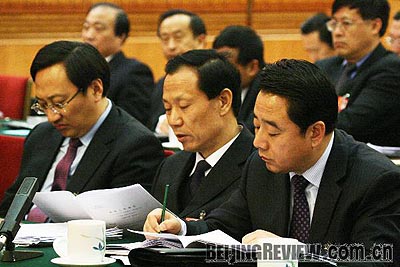|
To firm up employment, the government is supposed to further support labor-intensive private enterprises, which are the biggest employers, and at the same time provide more vocational training for returning migrant workers.
Rural Prosperity
Chen Xiwen, Vice Chairman of the Committee for Economic Affairs under the 11th CPPCC National Committee and Director of the Office of the Central Leading Group on Rural Work
The subdued prospects for economic growth have increased the importance of bolstering domestic consumption, and rural consumption in particular. A basket of spending plans to upgrade rural infrastructure, subsidize appliance purchases for farmers, and extend rural access to healthcare and schooling will boost farmers' livelihoods and spending power. The countryside will also gain momentum from policies to increase the minimum purchase prices of grains and expand government and commercial reserves of food.
 |
|
LISTENING ATTENTIVELY: The 11th NPC deputies from the Jiangsu delegation concentrate on the meeting proceedings (WEI YAO) | The severe drought in north China earlier this year will not put much of a dent in China's grain output, because the winter harvest makes up only around one fifth of the total. The government's timely drought-relief efforts have also helped ease the pain.
Currently, about 20 million rural migrants have lost their jobs as a result of the export collapse that drained life from the world's third largest economy. But the number has not showed signs of escalating, because many factories reopened after the Spring Festival and absorbed some of the workforce. As Premier Wen's work report highlighted, the government is acting swiftly to help them get reemployed or start up their own businesses. With more favorable policies coming into play, the country's job market is bound for a rally.
Fiscal Lifeline
Jia Kang, member of the 11th CPPCC National Committee and Director of the Research Institute for Fiscal Science under the Ministry of Finance
The strong increase in fiscal spending for 2009 plus its leverage effect should provide a floor under the slackening economy. The easing monetary environment and revitalization programs for the 10 backbone sectors will also pump steam into the industries.
In recent weeks, there have been initial signs of the economy starting to find its footing after a slowdown in the fourth quarter of 2008. New domestic currency lending has surged since November and hit a record 1.6 trillion yuan ($234 billion) in January, while power consumption in the eastern coastal provinces rebounded in February. But it remains to be seen whether these signs will turn into a more sustainable trend. Even if not, China still has plenty of scope to jumpstart the economy later this year.
According to the work report of Premier Wen, China's national budget deficit will jump more than sevenfold this year to 950 billion yuan ($139 billion), still below the international threshold of 3 percent of GDP. The United States, by comparison, is budgeting for a deficit of 12.3 percent of its GDP. However, policymakers should take a cautious approach to more tax waivers for absolute fiscal safety.
Compared with other countries, China has several potential advantages in economic resilience-relatively cheap labor and a buoyant domestic market, as well as unmatched budget flexibility. Those advantages will translate into real growth with the help of the stimulus measures.
Enough Stimuli

Li Deshui, member of the 11th CPPCC National Committee and former Commissioner of the National Bureau of Statistics
As the work report of Premier Wen indicated, this year will see a heady investment boom in China to offset the export contraction that is bearing down the economy. For a country like China, which is well positioned to turn around the current gloom, the goal of 8-percent growth this year is reasonable and realistic.
But we should draw a clear line between China's economic slowdown and the deep recessions of Western countries. The Chinese economy grew a modest 6.8 percent in the fourth quarter of 2008-the worst record in seven years-but was still the envy of Western countries sinking into deep recessions. Moreover, Chinese banks made an outpouring of loans this January to buck up economic growth while many of their Western counterparts were struggling to thaw a credit freeze.
That's why I believe extra stimulus measures beyond the 4-trillion-yuan ($586-billion) package are unnecessary. Premier Wen's work report underscored a considerable fiscal expansion, which combined with the credit boom will result in the vibrant stimulus we need.
More importantly, the fiscal package also adequately targeted new growth drivers, such as the consumer market and the service sector. This is crucial to rebalancing the growth model and polishing long-term economic prospects.
China's per-capita GDP surpassed $3,000 in 2008, signaling an accelerated urbanization and industrialization process to come. This also fosters a favorable economic climate for us to propel growth and restructure the economy.
Aiding SMEs
Yu Kwok-chun, member of the 11th CPPCC National Committee and General Manager of Hong Kong Yue Hwa Chinese Products Emporium Ltd.
Chinese small and medium-sized enterprises (SMEs) employ the majority of workers-three out of four. They are also a big contributor to GDP growth. Now, with a shaky employment landscape in sight, policymakers are painfully aware of the importance of keeping smaller businesses afloat. But the question is how to warm up their souring business mood while overseas markets continue to buckle. Personally, I believe the following measures could be instrumental in aiding the beleaguered SMEs.
First, the government should prompt commercial banks to increase financing support to vulnerable SMEs whose supply chains have broken down because of a lack of cash. The banks' willingness to lend to SMEs is at its lowest level because of a risk-averse sentiment amid the downturns. Other options available include improving the guarantee system for funding SMEs and pushing ahead with the development of rural banks and microcredit.
Second, SMEs should be offered a chance to participate in the massive infrastructure projects that will generate juicy returns.
Third, the SMEs themselves should also make efforts to innovate their outdated technologies and old management modes so they are not forced out of the market in cutthroat competition. Meanwhile, they should also attach importance to brand promotion for a firm foothold at home and abroad.
Fourth, SMEs should be responsible for strengthening vocational training for their employees. This would help mitigate employment stress and also benefit the enterprises. | 